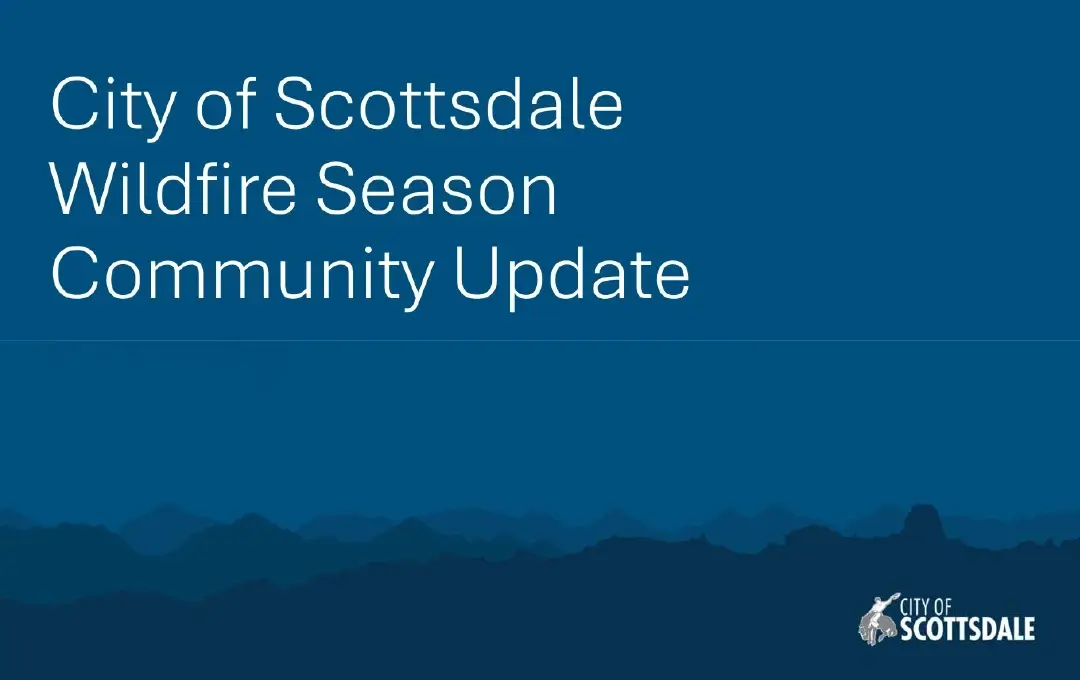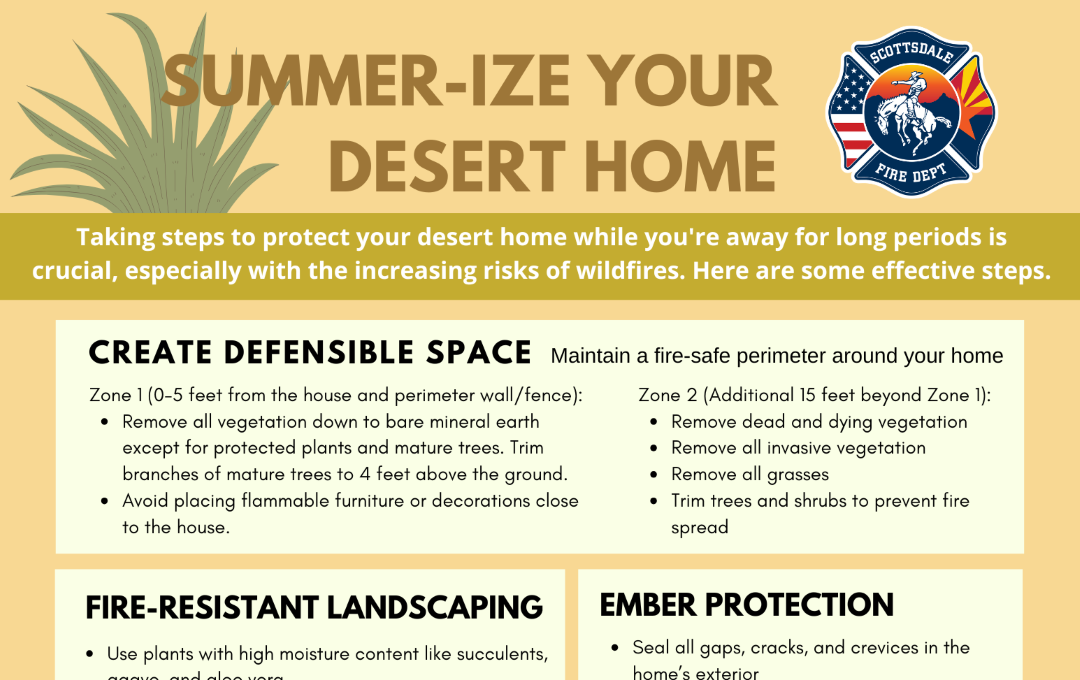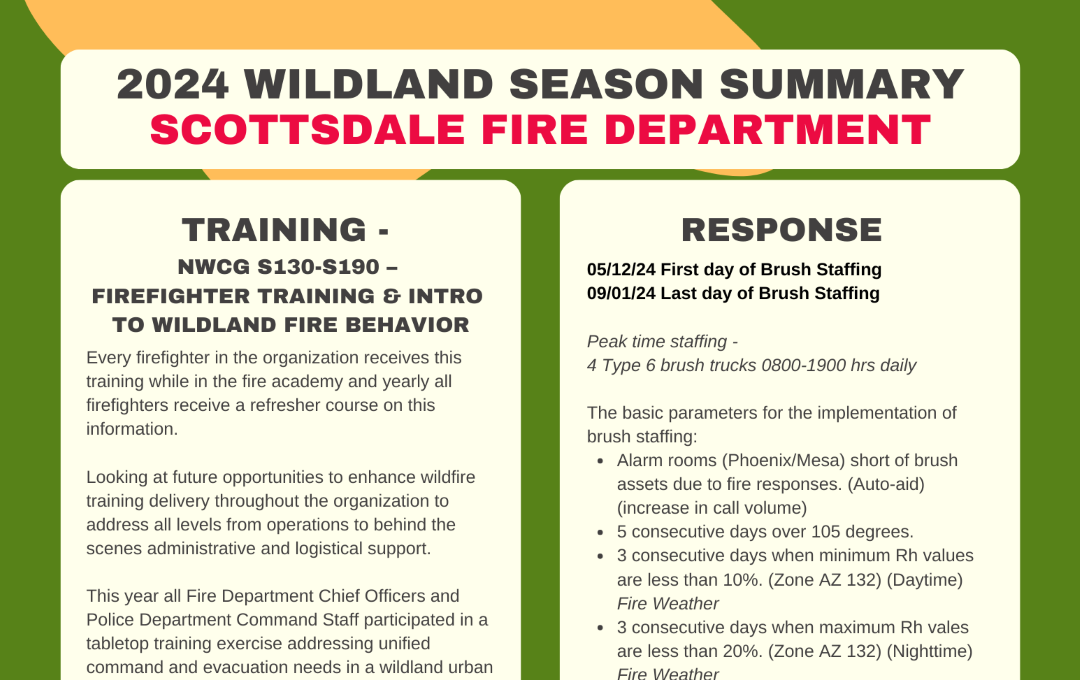Report brush fires immediately by dialing 911. Never assume someone else will make the call.

Wildfire Season Community Update
Download wildland fire season training summary and brush fire statistics.

Summer-ize your Desert Home
Taking steps to protect your desert home while you're away for long periods is crucial...

2024 Wildland Season Summary
Download the 2024 Wildland Season Summary
Overview
Know what to do if a brush fire breaks out
Wildland fires burn rapidly and winds often make them unpredictable. So, be very cautious when attempting to control a brush fire with a garden hose.
- Report brush fires immediately by dialing 911. Never assume someone else will make the call.
- Back your car into the garage or park it in an open space facing the direction of escape. Shut doors and roll up windows. Leave keys in ignition. Close garage doors/windows. Disconnect automatic garage openers.
- Confine pets to one room. Make plans to care for pets in case you must evacuate.
- Follow instructions of emergency personnel. If advised to evacuate, do so immediately.
- Wear protective clothing, sturdy shoes, cotton or wool clothing, long pants, long sleeved shirt, gloves and handkerchiefs to protect your face.
- Lock your home. Tell someone when you left and where you're going. Choose a route away from fire hazard. Watch for changes in fire's speed and direction.
The National Fire Protection Alliance (NFPA) has a FREE 20-minute course that covers the basics of wildfire and provide additional online training and resources on ho to prepare you home and property.
Protect your property - know the zones
Scottsdale Fire Officials are anticipating a significant potential for wildland fires which are fed by dried grasses and flash fuels. Brush fire season typically starts in mid-April and continues through September. Wildfire readiness is key: Start taking steps today to be protect your property and family!
Download Wildland Fire Prevention Brochure
Defensible Space Protects Your Home
Homeowners and contractors should create a well-maintained, live vegetation zone to prevent damage to structures in case of wildland fires. This "defensible space" acts as a fire break and should contain only small brush and ground cover to prevent a continuous path of flammable materials leading to inhabited structures.
Preventative Actions
- Maintain a 15-foot zone around your home; remove perennial grasses and thin, overgrown bushes; remove dead branches or branches touching the ground.
- Remove dead vegetation that is down on the ground from an additional 15-foot zone for maximum protection (30 feet total).
| Defensible Space | Action 1: Trim Live Vegetation | Action 2: Remove Dead & Down Vegetation |
|---|---|---|
| Homes | 15 feet | 15 feet |
| Walls | 5 feet | 15 feet |
| Roads | 10 feet | 20 feet |
| Construction | Building envelope | 30 feet outside building envelope |
Disposing of Your Brush Material
To keep your brush collection efficient and on schedule, residents are encouraged to use the following options to manage and dispose of property brush:
- Utilize Your Monthly Brush and Bulk Collection
You can place out a pile no larger than 10’L x 6’ W x 4’H at the curb no more than three days before the Monday of your designated collection week. Find more information on brush collection. - Roll-Off Container Rental
Rent a roll-off container for your home or community for a fee. This options ensures all materials are promptly collected and disposed of. You can find more information, or you can research private haulers services. - Professional Landscaping Services
Hire a landscaper to remove and properly dispose of brush and yard debris. - Resident Landfill Program
Through the city’s contract with the Salt River Landfill, residential solid waste customers may haul up to 2,000 pounds of trash, brush or bulk items to the landfill once per calendar week (Monday through Saturday) If you exceed one landfill use per calendar week, the charges will be reflected on your next utility bill. You can find more information on the program.
Ensure your contractors take fire safety precautions
Be vigilant! Keep construction sites safe and free of combustible materials.
- Limit welding & cutting to cleared areas.
- Remove all flammable products & flash fuels.
- Maintain the building envelope as a "clear zone" and thin an additional 30-feet to provide adequate defensible space.
- Do not stack wood or other flammable construction materials in defensible space.
Review the tips for wildland fire prevention
- Consistently monitor defensible space for maximum fire prevention.
- Remove flash fuels such as dead grass (Do NOT remove live native plants from NAOS).
- Trim trees within the 30-ft defensible space so the canopy is not touching the ground; remove any dead branches or leaves.
- Trim grass and foliage around trees.
- Keep gutters, eaves and roof clear of leaves and other debris.
- Do not stack wood or other flammable materials within the 30-ft defensible space.
- Keep a rolled up garden hose with a nozzle attached to an outside hose valve connection.
- No smoking allowed in NAOS.
Additional tips (for non-NAOS areas):
- Deposit all cigarette butts in proper containers. Never throw a cigarette butt onto the ground.
- When camping, follow local agency rules for campfires. Do not build a fire without making sure open fires are allowed, and always follow fire safety information.
- Add a spark arrester to off-road vehicles and other small internal combustion engines such as generators.
Tips for Homeowners Living in the High Sonoran Desert
Remove invasive plants
What is an Invasive Plant?
An invasive plant is generally not native to the Sonoran Desert. These plants compete with native plants and could take over an area. Invasive plants upset the sensitive and natural ecological balance of the surrounding area and can also disrupt the habitat for desert wildlife. In addition to the impact on native plants, this vegetation becomes a major fire fuel source during the hot weather when these weeds dry out.
Scottsdale has created a brochure that outlines the top eight identified to exist in the McDowell Sonoran Preserve.
Download Invasive Plants Brochure
The University of Arizona has created a homeowner's guide to help identify weeds and invasive plants.
View An Arizona Homeowner's Guide to Identifying and Managing Invasive Plants
As development pushes into the Sonoran Desert, an unintended consequence has been the introduction and spread of invasive plants into natural area open spaces (NAOS). The ecological damage caused by this unwanted vegetation negatively impacts the desert landscape by:
- Replacing native plants
- Damaging the ecosystem by displacing native plants
- Eliminating preferred plants for forage
- Creating fuel for fire and promote the spread of fires
- Altering water flow patterns
All these elements can permanently alter the landscape of our Sonoran Desert. Invasive plants upset the sensitive and natural ecological balance of the surrounding area, are a fire hazard and can also disrupt the habitat for desert wildlife.
Download the Guide to Natural Area Open Space
How Can You Help?
- Learn to identify problem plants
- Remove invasive plants from private property
- Work with your landscaper/gardener so native plants take priority in your yard
- Report infestations in common areas to your homeowner association board
- Add these plants to your homeowner association’s prohibited plant lists
- Learn about proper eradication methods
- Join a recognized volunteer weed removal group, get trained and participate
- Ask the nursery where you buy landscape materials to stop carrying these plants
- Help the Fire Department by providing a defensible space on the portions of your property that are nearest to structures and adjacent to natural Sonoran Desert areas
Requirement: Prior to modifying any portion of a dedicated natural area open spaces (NAOS) you must review the Environmentally Sensitive Lands Overlay (ESL) get approval from Scottsdale.
Residents are urged to contact Solid Waste at 480-312-5600 for more information or before any large clean-up or landscaping projects. Scottsdale will remove brush trimmings from residential properties for small clean-up projects on developed land only. Vegetation from washes, community common areas, undeveloped lots, and large projects is not the responsibility of city crews.
Last Updated: Apr 24, 2025
Fire
8401 E. Indian School Road Witzeman Public Safety Building Scottsdale, AZ 85251- Email Fire
- 480-312-8000 General Info
- 480-312-8911 Non-Emergency